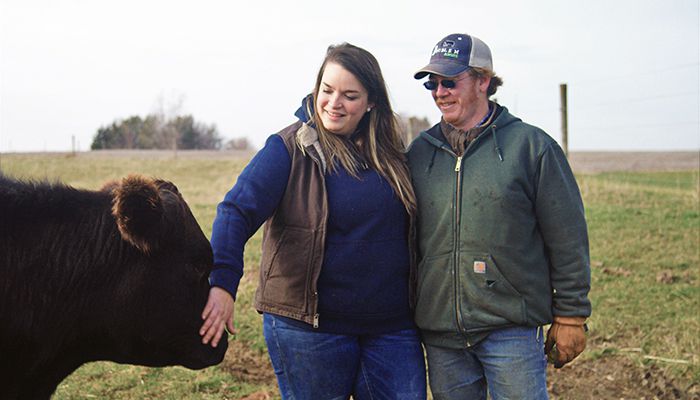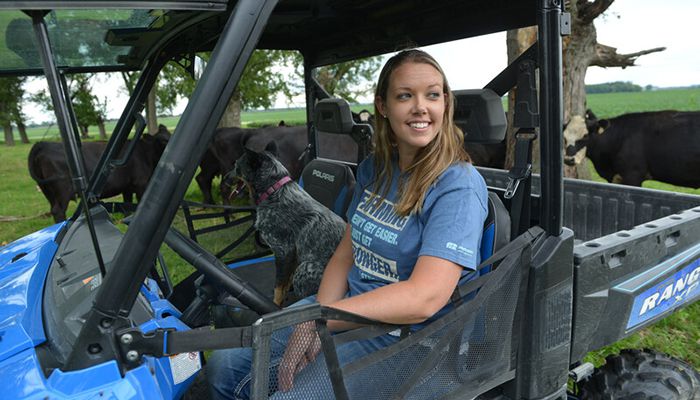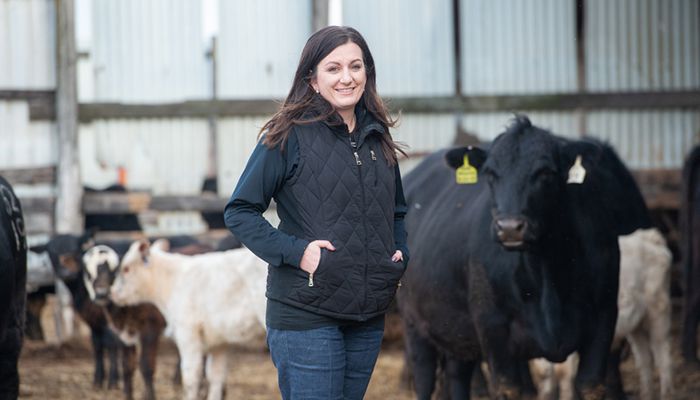Learn about cattle and how to cook beef from those who know it best—real farmers
Author
Published
5/24/2022
Thirty-one days isn’t nearly long enough to celebrate May Beef Month. Luckily, Iowa farmers are raising this versatile, real meat year-round.
I asked three farmers I know what they thought people would find surprising about raising cattle. Their answer? The time commitment. It's an everyday priority that comes before holidays, social activities and even a farmer’s supper. And no matter the weather conditions, their animals need them. It’s a calling they take pride in.
Hear more about their individual farms and favorite methods to cooking beef:
Ashley Thompson and Michael McEnany, Story County, Double M Angus

How do you make sure your animals are well cared for?
While people know farmers raise animals, they don’t see the late nights nursing animals back to health, assisting a mama birthing her calf, protecting animals during storms, baling hay, paying bills or all the maintenance that happens on the farm. We check on our animals every day, even with both of us having off-farm jobs. During calving season, these checks are every four to six hours. Our animals have a constant supply of hay as well as minerals and supplements to make sure they have the nutrients they need to thrive. The herd eats before we do! Our cattle are provided with veterinarian care and regular check-ups. We are also big advocates for continuing education. We participate in clinics (and sometimes re-take them as a refresher) to make sure we’re providing the best animal care possible.
What's your favorite way to prepare beef?
We recently invested in cast iron skillets. The sear and flavor have been amazing on our steaks. We keep it simple by adding butter to the pan and cooking it quickly. Then we add sliced potatoes and onions to the butter and steak juice. My (Ashley) favorite steak cut is the tenderloin, and Michael enjoys a good ribeye. We both agree though, somedays you can’t beat a good burger on the grill—especially when you get to share the meal with good company.
Hear more about Double M Angus and Ashley’s and Michael’s passion for animal care.
Laura Cunningham, Floyd County, SkyView Beef

What do you do on your farm to promote environmental sustainability?
On our farm, we use rye grass as a cover crop to reduce soil erosion and filter rainwater from August to May when there would otherwise be no crop in the field. The rye is harvested and bagged (like canning produce) to keep it fresh until the winter months when it's fed to the cattle as a protein source. On their own, cattle are also the ultimate upcyclers. They take grasses and leftover plant materials (like corn) people cannot digest and turn it into beef—a nutrient dense protein that helps toddlers, athletes and adults thrive! Just one 3 oz serving of beef provides 12 essential vitamins people and especially young children need every day. Then, manure produced by our cattle fertilizes our fields to grow another year’s worth of cow feed to consume during the winter when grass isn’t available.
What’s the secret to the best beef kabobs?
I cut a sirloin tip steak across the muscle grain into bite size pieces and marinade the beef overnight. While the typical kabob is a thread of beef chunks alternated with veggies, my tip is to keep the beef all on one kabob and veggies on the other. This will allow you to vary cook times and temperature placement on the grill to best fit what you're cooking. The beef works best low and slow for a few minutes on each side. I prefer a medium finish at 145 degrees. I will also make up a few skewers full of mushrooms, peppers and onions tossed in olive oil and coated with seasoned salt or chunks of pineapple or oranges to add some tang and citrus flavors to the meal.
Learn more from Laura about being a young farmer and agricultural advocate.
Ashley Recknor, Wright County, Purple Ribbon Beef

What changes have you made to your farm to continuously improve?
Sustainability is important to us, and we make decisions on our farm to ensure it is around for the next generation. This means working on sustainability efforts. On our farm, we look at our animals’ genetics. This plays into how adaptable they are and how much meat they produce while also allowing us to use fewer resources. It is a long process before a beef animal goes to market, and we work to check and ensure their health throughout the time they’re on the farm. We have also made strides in improving our farm’s soil health and the feed we are growing for the cattle. We rotationally graze our pasture ground, allowing for roots to stay put in the soil to capture nutrients and carbon.
What should people look for when they’re picking out beef cuts?
First, U.S. farmers are proud to raise accessible, quality beef. When people are looking for beef cuts, they should focus on their lifestyle and how they intend to prepare beef. Some meats taste better after they have been marinated a long time—like a skirt steak for fajitas. Other cuts like a chuck roast need to be cooked a long time on low heat for optimal taste while ground beef is great for a fast, quick meal. Tenderized steak cuts like minute or cube steak are also a great option for people with air fryers. If the cut of meat you have is not best suited for how you are preparing it, you will not be satisfied with the end result. Beef It’s What’s For Dinner has great tips on how to cook specific cuts of beef. Also, I highly recommend investing in a good meat thermometer!
Learn more about Ashley and her family’s Purple Ribbon General Store.
Want more news on this topic? Farm Bureau members may subscribe for a free email news service, featuring the farm and rural topics that interest them most!